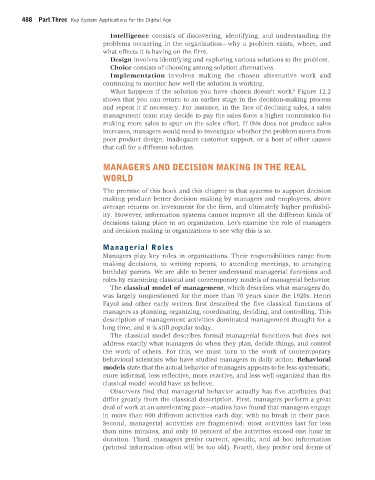Page 489 -
P. 489
488 Part Three Key System Applications for the Digital Age
Intelligence consists of discovering, identifying, and understanding the
problems occurring in the organization—why a problem exists, where, and
what effects it is having on the firm.
Design involves identifying and exploring various solutions to the problem.
Choice consists of choosing among solution alternatives.
Implementation involves making the chosen alternative work and
continuing to monitor how well the solution is working.
What happens if the solution you have chosen doesn’t work? Figure 12.2
shows that you can return to an earlier stage in the decision-making process
and repeat it if necessary. For instance, in the face of declining sales, a sales
management team may decide to pay the sales force a higher commission for
making more sales to spur on the sales effort. If this does not produce sales
increases, managers would need to investigate whether the problem stems from
poor product design, inadequate customer support, or a host of other causes
that call for a different solution.
MANAGERS AND DECISION MAKING IN THE REAL
WORLD
The premise of this book and this chapter is that systems to support decision
making produce better decision making by managers and employees, above
average returns on investment for the firm, and ultimately higher profitabil-
ity. However, information systems cannot improve all the different kinds of
decisions taking place in an organization. Let’s examine the role of managers
and decision making in organizations to see why this is so.
Managerial Roles
Managers play key roles in organizations. Their responsibilities range from
making decisions, to writing reports, to attending meetings, to arranging
birthday parties. We are able to better understand managerial functions and
roles by examining classical and contemporary models of managerial behavior.
The classical model of management, which describes what managers do,
was largely unquestioned for the more than 70 years since the 1920s. Henri
Fayol and other early writers first described the five classical functions of
managers as planning, organizing, coordinating, deciding, and controlling. This
description of management activities dominated management thought for a
long time, and it is still popular today.
The classical model describes formal managerial functions but does not
address exactly what managers do when they plan, decide things, and control
the work of others. For this, we must turn to the work of contemporary
behavioral scientists who have studied managers in daily action. Behavioral
models state that the actual behavior of managers appears to be less systematic,
more informal, less reflective, more reactive, and less well organized than the
classical model would have us believe.
Observers find that managerial behavior actually has five attributes that
differ greatly from the classical description. First, managers perform a great
deal of work at an unrelenting pace—studies have found that managers engage
in more than 600 different activities each day, with no break in their pace.
Second, managerial activities are fragmented; most activities last for less
than nine minutes, and only 10 percent of the activities exceed one hour in
duration. Third, managers prefer current, specific, and ad hoc information
(printed information often will be too old). Fourth, they prefer oral forms of
MIS_13_Ch_12 global.indd 488 1/17/2013 2:30:30 PM

